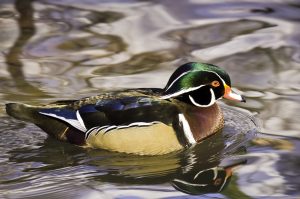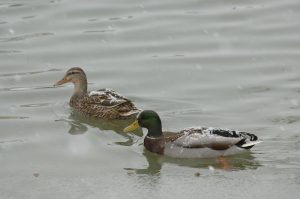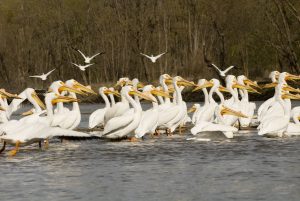Waterfowl Conservation in Southwest Illinois
By Carl Handel, Illinois Department of Natural Resources Wildlife Biologist
Historically, Illinois was wetland rich and consequently a waterfowl abundant land prior to settlement. What emerged was a strong waterfowling tradition among its citizens that extended from the early days of market hunting to some of the best waterfowl research and conservation in the nation. As a matter of fact, waterfowl, i.e. ducks, geese and other swimming birds, were so plentiful that Native American use as a food source was greater than turkey or deer in many locations. Early explorers such as the priest St. Cosme wrote in 1699: “No one need fast on that river (referring to the Illinois River), so great is the quantity of game of all kinds: swans, bustards or ducks.” DeLiette, in the late 1600s, wrote that when the marshes dried up in the fall it would cause the ducks, geese and swans to migrate to the main river channel. The birds were so abundant that you had to push them out of the way with your canoe paddle in order to navigate the water. Though most likely greatly exaggerated, it illustrates the great numbers of birds and rich resources that existed in what is now Illinois.

These large numbers most certainly were encountered during periods of migration, however, Illinois’ wetlands also supported local breeding populations in great numbers. Common breeders in Illinois would have been mainly mallards and wood ducks. Frank Bellrose estimated that wood ducks accounted for 90 percent of the breeding ducks in Illinois. Populations of Giant Canada Geese were also common as year round residents of Illinois. Fifteen other species of ducks have been recorded nesting in Illinois, but generally most continue on to the northern prairie pothole regions of the Dakotas and Canada or boreal forests of Canada.

Mallards and wood ducks are generally considered upland nesters. This means that nests can be up to several hundred yards from the nearest source of water as opposed to over or directly adjacent to water. Wood ducks nest in the forests of floodplains along rivers and streams or surrounding marshes. This is due to the habit of nesting in cavities of trees. Mallards on the other hand prefer wetlands with stable water levels and adequate ground vegetation nearby; principally grasses, herbaceous cover, marsh plants or shrubs. This is why urban residents will occasionally find a mallard nest in their shrubs or flower beds.

In Southwest Illinois, the American Bottoms provided the greatest wetland habitat for waterfowl. Legend has it that you could go from the village of Roots on the southern end to Cahokia on the north in a canoe with only a few short portages. Other wetland resources include the Kaskaskia River with its associated flood plain, smaller stream tributaries and flooded sink holes of the karst area.
CLIFFTOP, a local nonprofit organization, is focused on preserving and protecting area bluff lands.
A version of this article appeared in the October 4, 2019 edition of the Monroe County Independent.
©2019 all content rights reserved Clifftop NFP.
Comments are currently closed.
